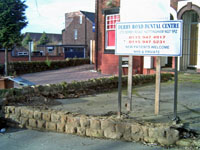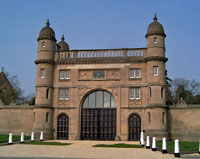News
In the midst of gloom comes hope
English Heritage is asking every local authority in England to fill in a questionnaire for each of their Conservation Areas as part of the first nation-wide census of the condition of this important element of our local heritage. The results will be announced and a campaign will be launched on 23rd June to help councils, communities and individual residents to care for these special places.

A destroyed section of Bulwell Stone wall in Nottingham.
Conservation Areas vary enormously. They include, for example, the Belgravia Conservation Area in central London, the industrial heritage of Birmingham’s Jewellery Quarter, the fishing village of Clovelly in North Devon and the Victorian People’s Park Conservation Area in Halifax. The heart of a historic town might be a Conservation Area. So too might be a street of well-preserved 1930s semi-detached houses or an isolated group of farm buildings. Details of local Conservation Areas are held by local councils and can usually be found on their websites, but these lists do not tell us what condition are they in: whether, for instance, they are cherished through a close partnership between local residents, businesses and the council in question. Nor do they tell us about those conservation areas at risk from neglect, decay and inappropriate development. By any measure, this is a mammoth task which English Heritage have set themselves.
If any person can make this happen it is Dr Simon Thurley, Chief Executive of English Heritage. When he asks 'Are sash windows still gracing house-fronts or are Conservation Areas suffering from a plague of plastic ones? Are front gardens being lost to car parking? Are the hearts of our most historic towns and suburban high streets under threat from the wrong kind of change? Does the existence of an active local amenity society make a difference?' he is addressing the concerns and passions of community activists and local historians across England.

A house in Lenton Conservation Area, Nottingham, in the process of having its 110 year old sash windows replaced by uPVC non-environmentally friendly windows.
These are just some of the questions English Heritage will be asking in the first national census of some 9,300 conservation areas in England. This is a 'strategic, national campaign', so don't expect English Heritage to get involved in individual issues at a local level. However, English Heritage will be providing residents and local groups with information and advice, and explaining how they can help by working constructively with local authorities to manage the places they value most. As Simon Thurley says, 'There is a lot that residents can do themselves and we will support Conservation Officers in their work to halt decay and inappropriate change before it is too late'.
Whilst English Heritage cannot get involved in individual campaigns, I am sure they will not shirk from highlighting the shortcomings of local councils who would like the world to believe that they cherish and care for their conservation areas when, in fact, they don't. The conservation area in wich I live (New Lenton, Nottingham) was created in 1975 and thirty-four years later we are still waiting for an Area Appraisal & Management Plan to be published (one was promised for 2008, now it's 'by the end of 2009'). The City Council abolished its Conservation Areas Advisory Committee some ten years ago and has had no mechanism for discussing conservation issues with local residents since then.

Lenton Lodge, less than half a mile from the Lenton house, has fared a little better, thanks to its listed building status, although until recently it was on the English Heritage Buildings at Risk Register.
We have watched Victorian houses in Lenton have their wooden sash windows stripped out by private landlords (who own most of the houses in our part of Nottingham) and replaced by uPVC windows, with ugly, thick frames, because Nottingham City Council refused to use its powers to prevent it happening. The city has 30 conservation areas, some created as long ago as 1969, 11 of which have Area Appraisals & Management Plans ― documents which took, on average, 22 years to compile and publish. Seven of the 11 Appraisals were published in 2007 and 2008. 19 areas are still waiting for an appraisal to be published after an average of 28 years since their creation. When the findings of the English Heritage census are published later this year, it will be interesting to see how individual local authorities are performing, especially whether they achieve the standards set out in the Audit Commission's Best Value Performance Indicators 2005/06 list for 'Preserving the special character of conservation areas' (BVs 170c, 219a, b & c).
It will also be interesting to see how local and national news media respond* to this campaign by English Heritage to draw attention to conservation areas. Some of them may have their focus elsewhere, either on the national financial crisis with all its ensuing consequences or on escapist trivia. Some, including, Local History Online, will see the launch of such an initiative in the midst of gloom as the triumph of hope over experience, something to be embraced and praised for what it can become.

Simon Thurley, Chief Executive of English Heritage.
I see a link, albeit tenuous, between what English Heritage are doing in 2009 and what happened in early 1941, when our wartime coalition government told local councils 'to plan boldly and comprehensively for a better post-war Britain'. This was at a time when the outcome of the Second World War was far from certain. Hitler had not yet attacked Russia (June 1941) and America did not enter the war until December 1941. Amidst the uncertainty of it all, precious national and local resources were being devoted to a better post-war Britain. To have been a working class housewife in Middlesbrough 'being interrogated' by a middle class volunteer about what she wanted for her family and friends in a post-war Middlesbrough, with perhaps her husband, a brother or a son (or all three!) fighting in North Africa or the North Atlantic, must have seemed odd. Yet people, when given the opportunity, wanted to participate, wanted to ensure that better homes, schools and hospitals were built, and that their communities were better planned and managed. It is an initiative with far greater potential than Simon Thurley and his colleagues may have originally imagined, coming at a time when the peoples of England and Britain need to look beyond the immediate social and economic challenges they face if they want to create a future which really does offer the prospect of a better life to all.
Communities which protect their environment in all its aspects, of which historical buildings and open space are only part, are better places to live and work. They are also more attractive to visitors. It applies as much to inner-city neighbourhoods, like Lenton where I live, as it does to villages and suburbs or historic city and town centres. Even if you don't buy into the environmental arguments, you would be silly to ignore the economic fact that conservation areas increase property values.
English Heritage also want to hear about major successes and might feature your local amenity society in their campaign booklet and on their website. To receive information and get involved in the campaign, please visit www.english-heritage.org.uk/conservationareas.
*Just after I had completed this report, news that the English Heritage Press Office is rushed off its feet with enquiries. Thank goodness the media still recognise a good news story when they see one!
Robert Howard
